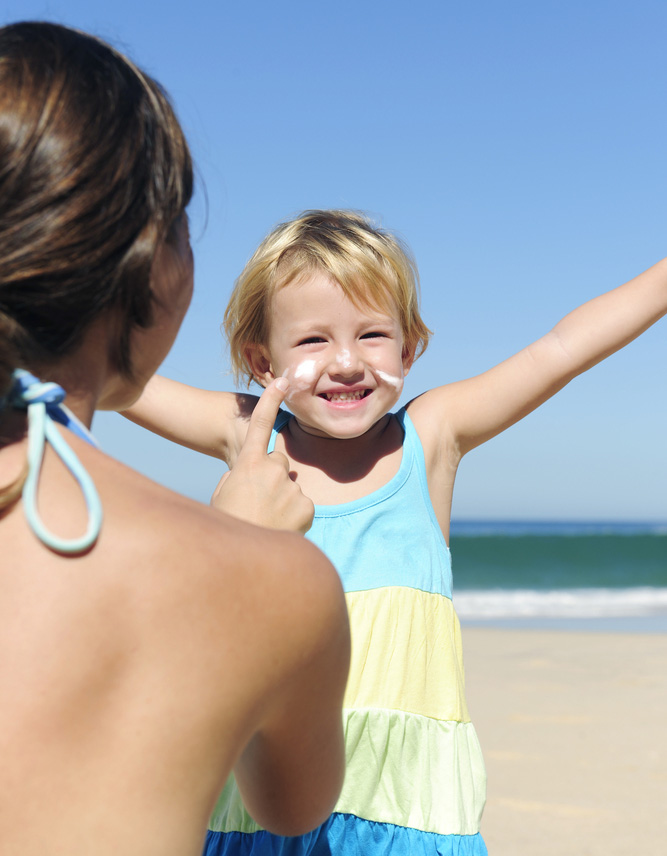We are an active family, every chance we get we are on a hike, or bike ride or at the park. My three boys NEED it. They are well behaved and sweet, as long as they get exercise daily—essentially they are like our dogs!
I am obsessed with sun safety; with the many hours outside, I worry that their pasty skin (sadly inherited from me) will develop sun damage. Sure, burns are uncomfortable, but this is just a small piece of the puzzle. It’s ongoing sun damage that happens over years that can lead to cancer.
It is a balance, as children do need vitamin D, and for this they need exposure to sun. Unprotected exposure to the sun’s ultraviolet rays can lead to skin damage, immune system suppression and skin cancer.
Main types of ultraviolet rays
- UVA – This type of ultraviolet rays lead to wrinkling, aging and risk of skin cancer. This is the majority of our sun exposure. Tanning bed use increases the risk of skin cancer exponentially, especially if exposed before 35 years of age
- UVB – These rays cause sunburns, suppressed immune system and cataracts. Melanoma, the most dangerous of skin cancers, is associated with severe UVB sunburns that occur in childhood.
The risk of damage from the sun is related to the intensity and duration of sun exposure. Therefore, children that are outside for more hours of the day, at peak times (typically between the hours of 10 AM-4 PM), are more at risk of sun damage. Children that are most at risk have:
- Very fair skin
- A family history of skin cancer
- Moles on the skin
So how can you prevent sun damage?
Avoid the sun at peak hours
UV is strongest in summer, near the equator and at high altitudes. Therefore, even when skiing in the winter, if at high altitudes, you may need sunscreen. The sun is at its highest and strongest. If your children are in the sun please apply sunscreen. Most sun damage occurs during incidental exposure during day-to-day activities.
Even when it is cool or cloudy outside, ultraviolet rays travel through the clouds—those clouds give a false sense of protection that just isn’t there. This “hidden sun” can actually cause sunburn too. Please avoid tanning beds, as those used that are at much increased risk of melanoma.
Cover up
Ultraviolet protecting shirts and shorts will help prevent burn and damage. And never forget to wear a hat.
Use sunscreen consistently
There are now thousands of different sunscreens available for children. I suggest using a barrier sunscreen, which is made from zinc or titanium. These act as a physical barrier to the sun. Try to select SPF of 30 or higher to prevent sunburn and sun damage. Ensure your sunscreen protects against both UVA and UVB. If your child has very sensitive skin, try using a sunscreen with no PABA. Apply sunscreen whenever your children are in the sun or will likely be in the sun for any period of time.
Tips to apply sunscreen properly
- Apply sunscreen15 to 30 minutes before kids go outside
- Don’t forget the ears, hands, feet, behind the neck and shoulders.
- Apply sunscreen underneath the straps of bathing suits and clothing to ensure that the skin is covered when the clothing moves.
- Reapply sunscreen often, at least every two hours. If your child is playing with water or is sweating, apply sunscreen more frequently
- Consider using a waterproof sunscreen if your child will be wet.
Protective eyewear
Sun can damage the eyes as well as the skin. Cumulative exposure can lead to cataracts later in life. Get sunglasses that have a label that says they provide 100% UV protection.
Remember—sun damage occurs over years. Protect your child now to prevent issues down the road. Model good sun protection behavior and your child will follow suit!


[…] How To Keep Your Family Sun Safe This Summer By Dina Kulik […]